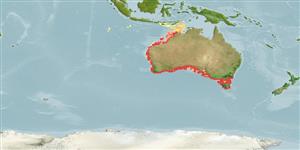Actinopterygii (ray-finned fishes) >
Perciformes (Perch-likes) >
Labridae (Wrasses)
Etymology: Achoerodus: Greek, a = without; also with the meaning of copulative particle = with + Greek, choiros = pig + Greek, odous = teeth+B103 (Ref. 45335).
Environment / Climate / Range
Ecology
Marine; reef-associated; depth range 5 - 65 m (Ref. 9563). Subtropical, preferred ?
Eastern Indian Ocean: southern Australia, from southern Western Australia to South Australia.
Length at first maturity / Size / Weight / Age
Maturity: Lm 65.3 range ? - ? cm
Max length : 175 cm TL male/unsexed; (Ref. 9563); max. reported age: 70 years (Ref. 94078)
Adults are found on the continental shelf (Ref. 9563). They inhabit rocky areas and feeds on small crabs, fish, mollusks and starfish (Ref. 2156). Oviparous, distinct pairing during breeding (Ref. 205). Protogynous (Ref. 94078).
Life cycle and mating behavior
Maturity | Reproduction | Spawning | Eggs | Fecundity | Larvae
Oviparous, distinct pairing during breeding (Ref. 205).
May, J.L. and J.G.H. Maxwell, 1986. Trawl fish from temperate waters of Australia. CSIRO Division of Fisheries Research, Tasmania. 492 p. (Ref. 9563)
IUCN Red List Status (Ref. 115185)
CITES (Ref. 94142)
Not Evaluated
Threat to humans
Harmless
Human uses
Fisheries: minor commercial
More information
ReferencesAquacultureAquaculture profileStrainsGeneticsAllele frequenciesHeritabilityDiseasesProcessingMass conversion
Tools
Special reports
Download XML
Internet sources
Estimates of some properties based on models
Phylogenetic diversity index (Ref.
82805): PD
50 = 0.7500 [Uniqueness, from 0.5 = low to 2.0 = high].
Bayesian length-weight: a=0.00977 (0.00553 - 0.01726), b=3.05 (2.90 - 3.20), in cm Total Length, based on LWR estimates for this species & (Sub)family-body (Ref.
93245).
Trophic Level (Ref.
69278): 3.8 ±0.59 se; Based on food items.
Resilience (Ref.
69278): Low, minimum population doubling time 4.5 - 14 years (Preliminary K or Fecundity.).
Prior r = 0.19, 2 SD range = 0.09 - 0.40, log(r) = -1.66, SD log(r) = 0.39, Based on: 1 K, 2 tgen, 2 tmax, records
Vulnerability (Ref.
59153): High to very high vulnerability (66 of 100) .
